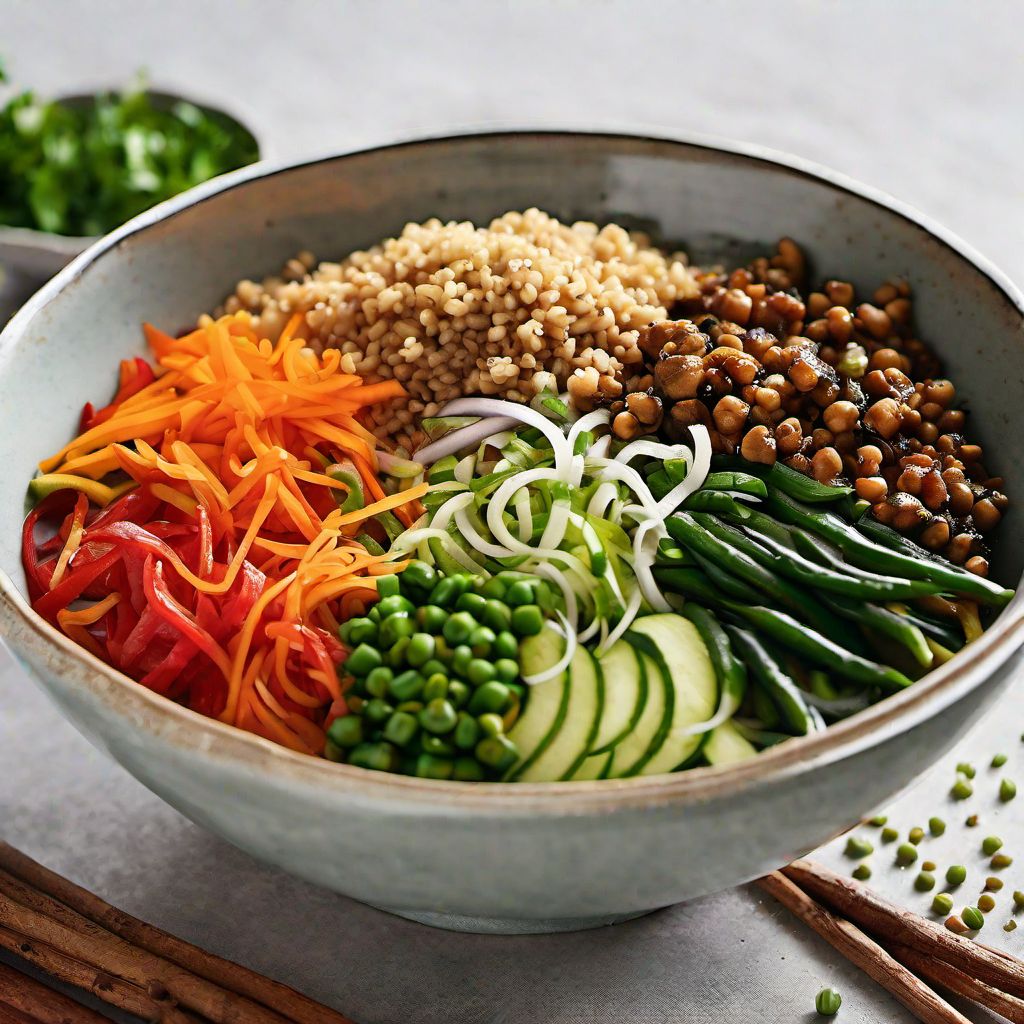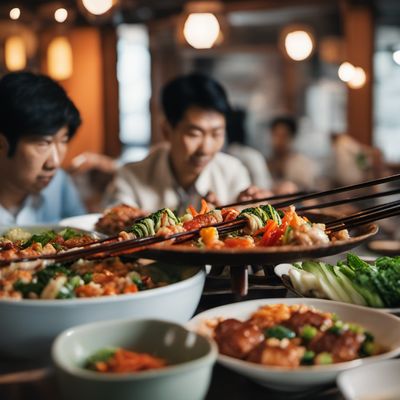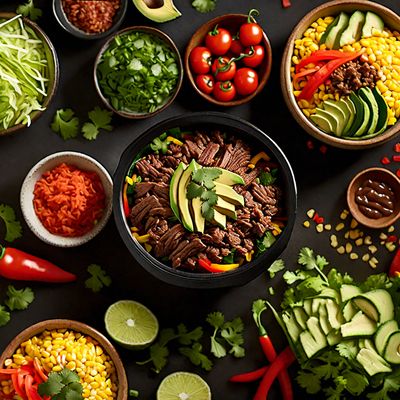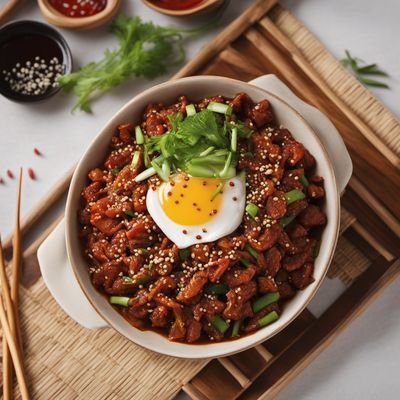
Recipe
Moroccan-inspired Bibimbap
Moroccan Spice Infused Bibimbap: A Fusion of Flavors
4.7 out of 5
In the vibrant world of Moroccan cuisine, we bring you a unique twist on the classic Korean dish, Bibimbap. This Moroccan-inspired Bibimbap combines the rich flavors of North Africa with the colorful and nutritious elements of the original dish. Get ready to embark on a culinary adventure that will tantalize your taste buds and transport you to the exotic land of Morocco.
Metadata
Preparation time
20 minutes
Cooking time
15 minutes
Total time
35 minutes
Yields
4 servings
Preparation difficulty
Easy
Suitable for
Vegetarian, Vegan, Gluten-free, Dairy-free, Nut-free
Allergens
N/A
Not suitable for
Paleo, Keto, Low-carb, High-protein, Low-fat
Ingredients
While the original Bibimbap is traditionally made with Korean ingredients such as gochujang and kimchi, this Moroccan adaptation incorporates the aromatic spices and ingredients commonly found in Moroccan cuisine. The flavors of cumin, coriander, cinnamon, and saffron take center stage, adding a delightful twist to the dish. Additionally, we will be using Moroccan vegetables and herbs to enhance the overall Moroccan experience. We alse have the original recipe for Bibimbap, so you can check it out.
-
2 cups (470ml) cooked couscous 2 cups (470ml) cooked couscous
-
1 tablespoon olive oil 1 tablespoon olive oil
-
1 onion, thinly sliced 1 onion, thinly sliced
-
2 cloves garlic, minced 2 cloves garlic, minced
-
1 teaspoon ground cumin 1 teaspoon ground cumin
-
1 teaspoon ground coriander 1 teaspoon ground coriander
-
1/2 teaspoon ground cinnamon 1/2 teaspoon ground cinnamon
-
1/4 teaspoon saffron threads 1/4 teaspoon saffron threads
-
1 carrot, julienned 1 carrot, julienned
-
1 red bell pepper, thinly sliced 1 red bell pepper, thinly sliced
-
1 zucchini, thinly sliced 1 zucchini, thinly sliced
-
1 cup (150g) cooked chickpeas 1 cup (150g) cooked chickpeas
-
1 cup (150g) cooked lentils 1 cup (150g) cooked lentils
-
1 cup (150g) cooked peas 1 cup (150g) cooked peas
-
1 cup (150g) cooked green beans 1 cup (150g) cooked green beans
-
1 cup (150g) cooked spinach 1 cup (150g) cooked spinach
-
Salt and pepper to taste Salt and pepper to taste
-
Fresh cilantro, chopped (for garnish) Fresh cilantro, chopped (for garnish)
-
Lemon wedges (for serving) Lemon wedges (for serving)
Nutrition
- Calories (kcal / KJ): 350 kcal / 1465 KJ
- Fat (total, saturated): 6g, 1g
- Carbohydrates (total, sugars): 65g, 8g
- Protein: 12g
- Fiber: 10g
- Salt: 1g
Preparation
-
1.Heat olive oil in a large skillet over medium heat. Add the sliced onion and minced garlic, and sauté until the onion becomes translucent.
-
2.Add the ground cumin, ground coriander, ground cinnamon, and saffron threads to the skillet. Stir well to coat the onions and garlic with the spices.
-
3.Add the julienned carrot, sliced red bell pepper, and sliced zucchini to the skillet. Cook for 5-7 minutes, or until the vegetables are tender-crisp.
-
4.Stir in the cooked chickpeas, lentils, peas, green beans, and spinach. Season with salt and pepper to taste. Cook for an additional 2-3 minutes to heat through.
-
5.Divide the cooked couscous among serving bowls. Top with the Moroccan vegetable mixture.
-
6.Garnish with fresh cilantro and serve with lemon wedges on the side.
Treat your ingredients with care...
- Couscous — Fluff the cooked couscous with a fork before using to ensure a light and fluffy texture.
- Saffron threads — Soak the saffron threads in a tablespoon of warm water for a few minutes before adding them to the dish. This will help release their vibrant color and aroma.
- Fresh cilantro — Add the chopped cilantro just before serving to preserve its fresh flavor and aroma.
Tips & Tricks
- For an extra burst of flavor, toast the ground cumin, ground coriander, and ground cinnamon in a dry skillet for a minute before adding them to the dish.
- Feel free to customize your Moroccan-inspired Bibimbap by adding other vegetables such as roasted eggplant or steamed cauliflower.
- If you prefer a spicier version, sprinkle some harissa or chili flakes on top before serving.
- Experiment with different herbs like mint or parsley for added freshness.
- Serve the Bibimbap with a side of Moroccan flatbread or pita bread for a complete meal.
Serving advice
Serve the Moroccan-inspired Bibimbap hot, allowing the flavors to meld together. Squeeze fresh lemon juice over the dish just before eating to add a tangy brightness.
Presentation advice
To create an appealing presentation, arrange the colorful Moroccan vegetables on top of the couscous in an organized manner. Garnish with a sprinkle of fresh cilantro for a pop of green.
More recipes...
For Bibimbap » Browse all
For Korean cuisine » Browse all
More Korean cuisine dishes » Browse all

Yakgwa
Yakgwa is a traditional Korean sweet that is made from wheat flour, honey, and sesame oil. It is often served during festivals and special occasions.

Sanjeok
Sanjeok is a traditional Korean dish that is made with skewered meat and vegetables. It is a popular dish for special occasions and celebrations,...

Jumulleok
Jumulleok is a traditional Korean dish that is made with marinated beef that is grilled on skewers. The beef is typically marinated in a mixture...
More Moroccan cuisine dishes » Browse all

Harsha
Harsha is a traditional Moroccan bread made with semolina flour. It is a type of flatbread that is typically served for breakfast or as a snack,...

Chicken Tajine
Chicken Tajine is a traditional Moroccan dish made with chicken, vegetables, and a variety of spices.

Zaalouk
Eggplant and Tomato Salad
Zaalouk is a traditional Moroccan dish that is made with eggplant and tomatoes. It is a vegan dish that is often served as a side dish or as a dip...










